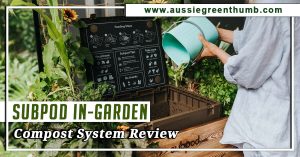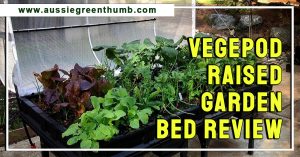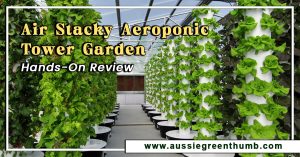Aeroponics offers space-saving gardening solutions for anybody and everybody. Whether you’ve got a tiny balcony garden or a vast plot with acres of space to play with, having more space is always at the top of gardeners’ wish lists.
Aeroponics has evolved from hydroponics, which developed into tower gardens to tackle that exact problem. Hydroponics offers a safer, cleaner way to grow fruit and vegetables without the risk of soil funguses, and poor water management that comes with traditional gardening.
Aeroponics takes it to another level, removing further pest and disease problems, and reducing the amount of water required to grow your crops.
In this buyer’s guide to aeroponic towers, we’ll look at the differences between hydroponics and aeroponics, in simple, easy-to-understand terms, and share a few of our favourite products for home gardeners which will, without fail, revolutionise your harvests.
More...
What are Aeroponic Tower Gardens?
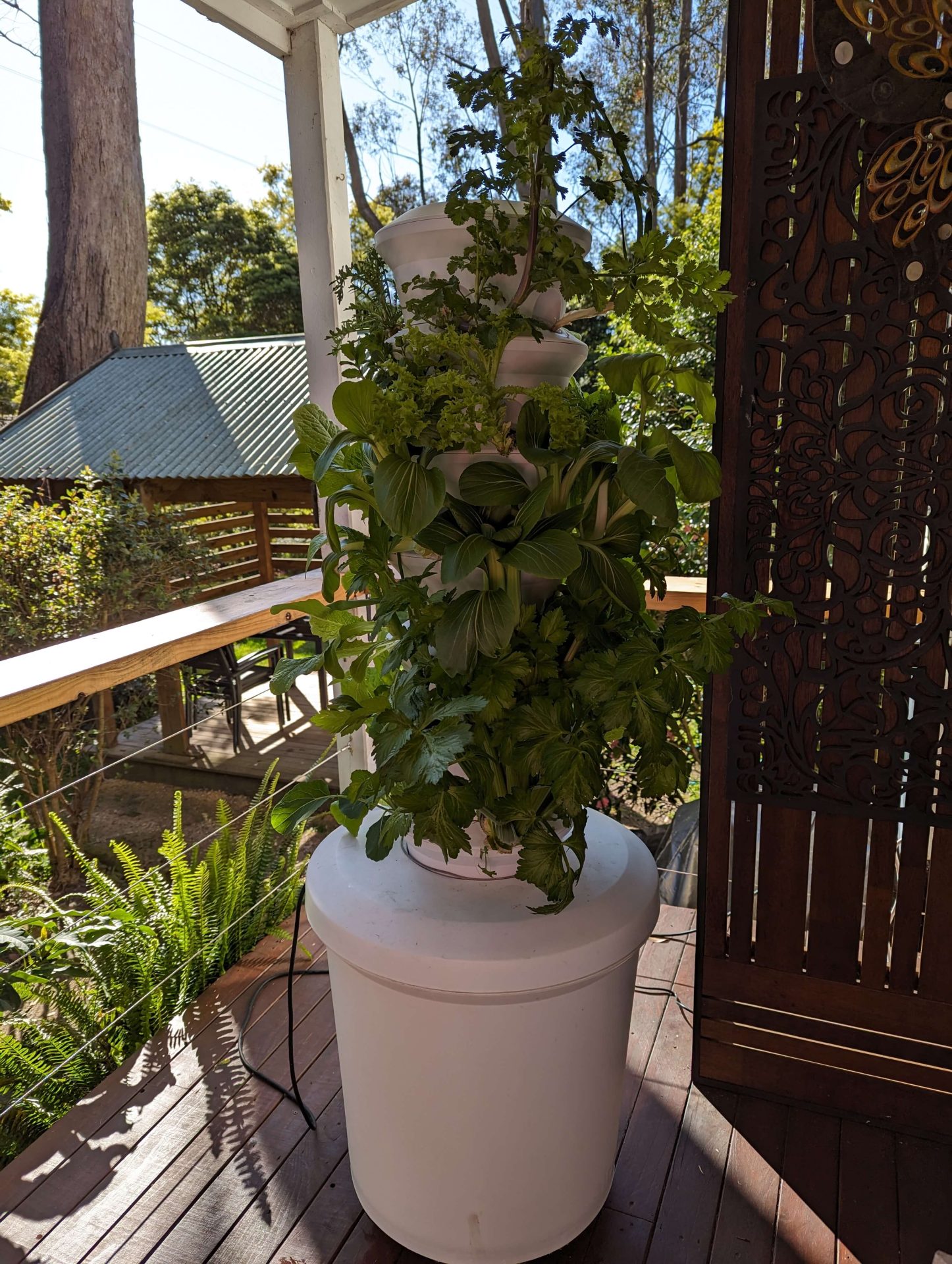
Aeroponic tower gardens do require some growing medium to provide a base for seeds to grow into. Beyond that, the roots grow out into dark, moisture-rich, nutrient-rich spaces, where they are managed by ventilated air and clean water.
The method can be done in rows and trays, rather than towers, but by growing upwards and in good light conditions, you can grow around ten times as much produce in the same space.
The two most popular products on the market right now are the Air Stacky by Mr Stacky, and the Airgarden Aeroponic Tower. But are produced to a high standard, and we’ve run product tests on both with excellent results.
What’s the Difference Between Aeroponics and Hydroponics?
The question we get asked most is whether there is a difference between hydroponic towers and aeroponic towers. The answer is a resounding yes… but with some caveats.
Neither term is legally protected, so some hydroponic systems call themselves aeroponics, and some aeroponic systems call themselves hydroponic. This isn’t to fool you, it's just because hydroponic is a more popular search term, and they’re driving at sales. The products are still just as good, but you need to get to grips with the mechanics of each so you know what you’re actually looking for.
Essentially, in aeroponics, roots can dry out overnight, while plants are dormant, they grow in open air, with water dripping onto, through and past them. The seeds are also germinated in advance of entering the tower system (hydroponics allows you to germinate seeds in situ).
Hydroponics do sometimes have the same set-up, with dripped or sprayed water, but the fundamental requirement of aeroponics is that roots do not sit in water. They are sprayed or moistened with running or passing water.
In terms of the physical set-up, there are many similarities between aeroponic towers and hydroponic towers – namely, they both have a reservoir, they both require mixed nutrients and regular pH testing, and they pump water to the top of a tower system that drip down feeding the roots.
Aeroponic Tower Garden Buyers’ Guide
To begin with, aeroponics might seem daunting, but because it is a fairly new way of gardening, there are actually not that many brands to choose from.
The limited selection and relative similarities between them mean that much of your choice will be down to style and price. But do try to make some common-sense decisions about how you plan to use them, and whether you can get hold of the refills, replacements and alternative parts when you need them.
Thankfully, all the towers we’ll talk about later in this review are tried and trusted, so you can be sure they’ll definitely work.
What to Look for When Buying an Aeroponic Tower Garden
As with anything you buy, the build quality is of paramount importance. If it looks flimsy, it probably is, and in many cases in the early stages of product design (as aeroponics is) a lot of smaller brands are essentially selling prototypes.
That’s not a bad thing, but choose where to put your support. If you believe in the product, sometimes supporting a new business can make a big, big difference, but if you’re just looking for a bargain, it’s usually worth sticking to the bigger brands.
If there was one real word of caution though, it would be to find something that’s going to work where you need it. Some hydroponic and aeroponic systems are designed for indoor use only. Outdoor systems are more expensive, but can also be run on solar power, making them much cheaper to run in the longer term.
And in doing so, you’re even using sunlight, rather than full spectrum lighting to grow your food (better for your veggies and better for your wallet).

Accessories for Your Aeroponic Tower Garden
Aeroponics is an investment in your garden, and yes, you can build your own, but even then, you’ll be buying growing mediums, fertilisers, and pH-balancing additives for the water tank. They save space, but because of the way they work, will always require additional materials to grow in and with.
Below, we’ll look at the sort of things you can save money on, and why, so your choice of aeroponic growing system isn’t defined by the brand’s own product range.
Aeroponic Fertilisers
It is definitely easier to get your nutrients straight from the aeroponic supplier, and the ones the tower brands sell are great, but you can use any balanced fertiliser in reality, with similar effects (many gardeners even make their own).
AutoPot A/B nutrients are a great budget-friendly choice, which offers all the basic nutrients to get you going. They are a great option if you’re after something simple and straightforward.
For something a bit more bespoke, one of the most raved-about hydroponic and aeroponic nutrient sets is the General Hydroponics Flora Series, with three bottles, each for different growth stages, and outcomes. It’s more expensive, but nearly everyone agrees it’s worth it for the results.
Coco Compost for Aeroponics
Most aeroponic tower gardens use universal materials, inside bespoke designs. For example, while the cages and pillars might be the same, the coir you use can be amended in many ways (e.g. adding slow-release fertiliser to the coir, or using coir fibre instead of coir compost for more rapid roots) and the fertilisers and nutrients you add to the reservoir don’t need to be on brand either.
Nutrifield’s 5kg block of coco coir, when expanded with water, makes about 75L of compost.
We add a generous handful of Osmocote’s Tomato Vegetable and Herb Plant Food to the expanded coir whenever we use it. It’s gentle enough not to harm seedlings, and it helps them to establish, feeding into the aeroponic system eventually, reducing how much expensive liquid nutrients are required (though it is worth keeping an eye on water pH if you do start adapting the growing conditions like this).
Plug Trays to Start Seedlings
Unlike hydroponics, seeds should always be germinated in trays outside of the aeroponic tower. This makes the whole process more time-consuming but it has one big benefit – you always have your next crop ready to go.
Any basic seed trays will do, but you can give the whole process a head start with a heated propagator (or save some money with a heat mat).
For larger seeds that are quicker to root (cucumbers, gherkins, etc.) start them in smaller seed cells filled with coir, and add them to the aeroponic tower as soon as they root through the bottom holes. They don’t like being moved, and root quickly, so you can grow more in a smaller space this way. Try these ten packs of small starter trays from Apipi.
Or for a lower-budget option that works best for tomatoes, peppers and aubergines, which need a little more time to establish a root ball before being transplanted, grow them in open-bottomed seed trays, which are affordable and practical, as well as ideally sized for most aeroponic towers.
How to Use an Aeroponic Tower Garden
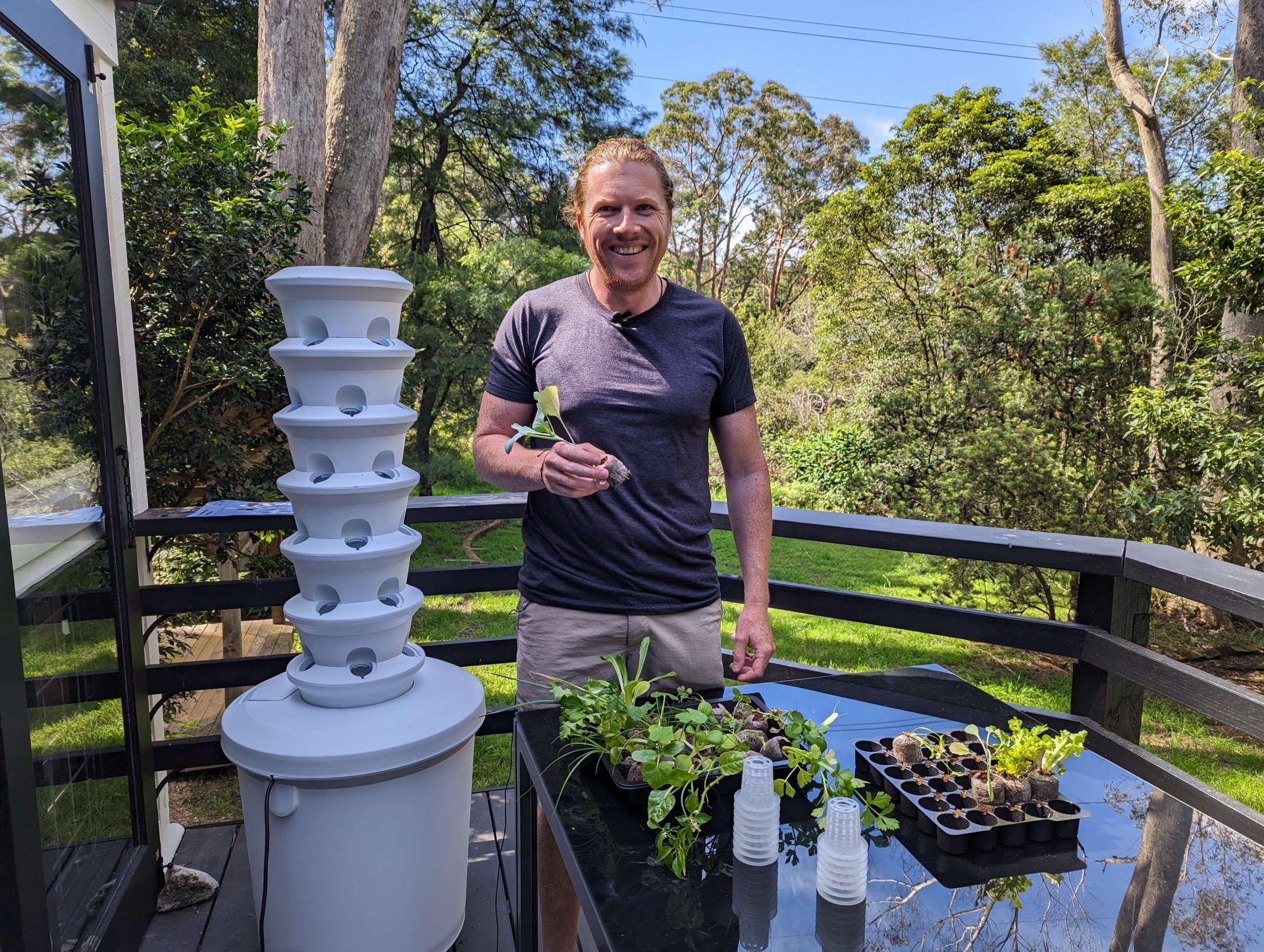
Nathan Schwartz preparing his aeroponic tower garden
Every tower garden is different but, fundamentally, all aeroponic towers are just devices misting plant roots with water and nutrients. Beyond that, how you use them is up to you.
You’re not going to break the tower by using different nutrients or trying it in different light conditions. In fact, most plants you plant into it will need just that anyway. Tomatoes need different nutrients to courgettes, and strawberries need their own treatment too.
Lighting-wise, there are some plants that will grow fully indoors with indirect light, while others are going to need full sun or grow lights to thrive.
Keep an eye on your plants. If they’re not growing slowly, or not at all, it's usually to do with nutrient levels, pH levels or light.
Light is the easiest to amend – just move your aeroponic tower. Nutrients and pH can be amended gently, by adjusting the pH or nutrient levels in the tank, using the products provided you can also make drastic changes to the conditions quickly, by emptying the tank and starting over if the pH or nutrients are too strong (particularly if the water becomes significantly more alkaline than it should be, which most plants will struggle with).
One benefit of aeroponics is that you can change the conditions so efficiently, but don’t do it too often, because every time you flush the system, you need to start from scratch with nutrients, and they’re not cheap.
Best Aeroponic Tower Garden for 2024
1. Airgarden Aeroponic Vertical Garden
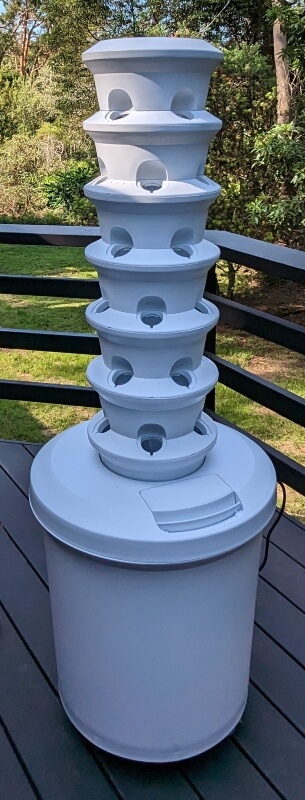
Airgarden is definitely the garden’s choice of aeroponic towers. It’s a little bit more hands-on, and it feels more engaged than some of the alternatives. You kind of get to know it's working while you’re putting it together, so the whole process feels a little bit more natural.
In terms of growing seedlings, there’s everything you need to get started supplied with the kit, and the coir plugs are insanely simple to use.
I like the tiered look of the planter too. It’s not the most exciting part of it, but it just looks a little bit more like part of the garden than the more common cylinder designs. The whole thing feels more considered and slightly more of a luxury as a result.
We grew salads, cucumbers and tomatoes in the Airgarden when we tried it, and they all did really, really well. We had a few issues with kale, but I think that’s maybe just the wrong plant to be growing in these kits (it struggled across a couple of different hydro/aeroponic kits we’ve tried) so it is probably more about its need for cooler seasons, rather than its root conditions.
Overall, the Airgarden is definitely worth investing in, short-term or long-term.
All of these kits throw statistics at you, about how much food you get vs the initial investment (apparently this pays for itself in just six months) but honestly, it's not about the money. This is a space-saving solution that means you get homegrown food all year round.
That’s enough incentive. Surely.
Read our product test for the Airgarden Aeroponic Garden for more details.
Pros
Cons
2. Air Stacky Aeroponic Vertical Tower Garden

Source: Mr Stacky
Air Stacky’s Aeroponic tower kind of fails the beauty test for me, but on every other criteria, it ticks the box and then some. This cylindrical tower might not look the best, but it is designed for practicality above all else.
Take its well-weighted reservoir, which sits flatter and wider than most other brands. That’s not just about weight distribution, it's about space. By having a lower reservoir, you get more vertical space to play with, and the Air Stacky manages to squeeze in a whole six extra planting pockets as a result.
The UV lighting that droops down over the whole system, again, doesn’t look great, but it means you can use this kit indoors or outdoors, regardless of where you live.
If you’re stuck with a cool, shaded, south-facing balcony in Victoria, you can grow your veggies perfectly using this system, with or without the lighting.
If you’re in the hot dry north and struggle to grow any produce outdoors, you can set the kit up indoors, in artificial conditions, and grow your own without the usual challenges.
It’s hard to separate this from its competitors and pick a favourite, but if it's entirely based on practicalities, I think the Air Stacky just about takes the best aeroponic tower award for 2024.
Refer to our in-depth review of Air Stacky Aeroponic Garden for more info.
Pros
Cons
Aeroponic Tower Garden Frequently Asked Questions
What are the disadvantages of aeroponics?
There are two real disadvantages of aeroponics. One is that they nearly always cost more than other ways of growing vegetables (but this is quickly offset by the increased harvest). The second is that the harvests will never taste like those grown in the ground – particularly watery fruits like strawberries or tomatoes.
Are aeroponics better than hydroponics?
Aeroponics produces more food and faster than hydroponics, with fewer pests and diseases present, and a simpler water management system. However, it is usually more expensive to get started with aeroponics, and running costs can be higher.
Which is better for the environment, aeroponics or hydroponics?
Hydroponics and aeroponics can be bad for the environment. They both use powered pumps to circulate water, but these pumps can be solar-powered. Aeroponics is a significantly better choice for environmentally concerned gardeners as it uses less water than hydroponics, despite the same power requirements.
How often do you have to change the water in aeroponics?
Aeroponics can use the same water for about a week on average but will use it all. Any nutrients left over should be replaced. You can mix larger batches if you are going to be away, but it is generally better to replace the water and nutrient mix in the tank once a week.
How long do aeroponics take to grow?
Salad leaves like rocket, mustard and butterhead lettuce are usually ready to harvest after three weeks and can be cut and harvested multiple times unless you want to grow them into full heads of lettuce.
Other plants like tomatoes or fruiting veggies, need longer but are usually about 10% faster than traditionally grown plants.
Do you need grow lights for aeroponics?
You don’t need grow lights for aeroponics, but for indoor systems, they are a requirement, simply because plants need that full spectrum lighting to photosynthesise properly. For outdoor aeroponic towers, there is no need to supplement sunlight with grow lights.
Is aeroponics faster than hydroponics?
For leafy greens like lettuce, basil, coriander or rocket, hydroponics is a faster-growing system than aeroponics, because the early stages of leaf development are quicker with the more readily available water.
However, aeroponics is faster than hydroponics for fruiting vegetables, which speed up significantly after the fourth or fifth week of growth in aeroponic systems.
Revolutionizing How You Grow Plants with Efficiency with Aeroponic towers
Aeroponics isn't for everyone, and old-fashioned gardeners, me included, will always have their doubts, but now we've had a chance to really get to grips with these systems, I have to admit that I kind of love them.
Every year, I find myself yearning for more and more space to grow my vegetables. Every year I run out of space. If these kits can offer more space, maximise my harvests, and help to reduce pests on my patch, then I’m 100% for them.
Even if you’re a bit sceptical of vertical growing, and aeroponics in particular, give them a go. Try out one of these great aeroponic towers and see for yourself the difference it makes.
Published on March 26, 2024 by Gary Clarke
Last Updated on June 6, 2024

